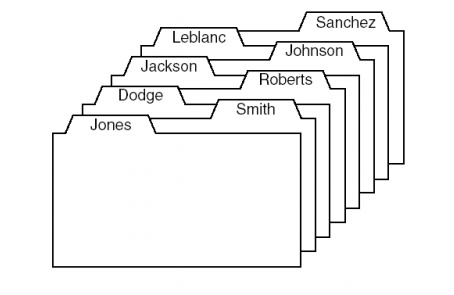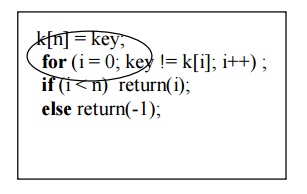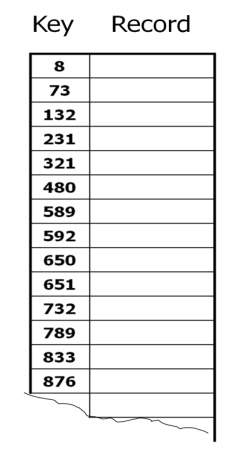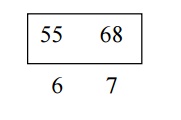Chapter: Programming and Data Structures : Sorting And Searching
Search Algorithm: Linear search or sequential search and Binary search
SEARCHING:
Search
Algorithm:
A search algorithm is an algorithm that accepts an argument and tries to find a record whose key is ‘a’. The algorithm may return the entire re record.
Basic Terminologies:
File: A table or file
is group of elements.
Record: Each
field in a table or file is known as record.
Key: Associated with
each record, which is used to differentiate among different records.
Three different keys,
Internal Key: The
key is contained within the record at a specific offset from the start of the
record, such a key is Internal or Embedded key.
External Key: There
is a separate table of keys that includes pointers to the records. Such keys
are External keys.
Primary Key: For
every file or table there is at least one set of a key that is unique.
Secondary Key: For
a table or file if searching done on the record which is not unique such a key
is secondary key.

Records and Keys
Internal search: Searching
key data stored in main memory
External search: Searching
key data stored in auxiliary memory
Retrieval:
Output of a successful search
1SEQUENTIAL SEARCHING:
Each searching function has two input parameters:
1. First
is the list to be searched;
2. Second
is the target key for which we are searching.
Each searching function will also have an output
parameter and a returned value:
The returned value has type Error code and indicates
whether or not the search is successful in appending an entry with the target
key.
If the search is successful, then the returned value
is success, and the output parameter called position will locate the target
within the list.
If the search is unsuccessful, then the value not
present is returned and the output parameter may have an undefined value or a
value that will differ from one method to another.
Definition:
Linear search or
sequential search is a method for finding a particular value in a list that
consists of checking every one of its elements, one at a time and in
sequence, until the desired one is found. Linear search is the simplest search
algorithm; it is a special case of brute-force search.
Algorithm:
#include<stdio.h>
main()
{
int array[100], search, c, number;
printf("Enter the number of elements in array\n"); scanf("%d",&number);
printf("Enter %d numbers\n", number);
for ( c = 0 ; c < number ; c++ ) scanf("%d",&array[c]);
printf("Enter the number to search\n"); scanf("%d",&search);
for ( c = 0 ; c < number ; c++ )
{
if ( array[c] == search ) /* if
required element found */
{
printf("%d is present at location %d.\n", search, c+1); break;
}
}
if ( c == number )
printf("%d is not present in array.\n", search);
return 0;
}
This search is
applicable to a table organized either as an array or as a linked list. The
algorithm examines each key in turn upon finding one that matches the search
argument, its index is returned. If no match found -1 is returned.
For efficient
searching algorithm we can add a node called sentinel node an extra key
inserted at the end of the array.

k[n] = key;
for (i = 0;
key != k[i]; i++) ; if (i < n) return(i);
else
return(-1);
Let p (i) be
the probability that record i is retrieved.
p(0)+ p(1)+ ... + p(n-1) = 1. Average number of
comparisons:
p(0) + 2p(1) + 3p(2) + ... + np(n-1) This number is
minimized if
p(0)
≧p(1) ≧p(2) ≧... ≧p(n-1).
Reordering a List for Maximum Search
Efficiency
There are two search methods that accomplish the
maximum searching efficiency are
i)
Move to Front
ii)
Transposition Method.
Move to Front:
In this method whenever
a search is successful the retrieved record is removed from its current
location in the list and is placed at the head of the list.
e.g. 9 5 6 8 7 2
(1)
search 6: 6 9 5 8 7 2
(2)
search 8: 8 6 9 5 7 2
The
retrieved record is moved to the head of the list.
Searching in an ordered table
If the table is in ascending or
descending order of the record keys, then there are several techniques that can
be used to improve the efficiency of searching.

An obvious advantage in
searching a sorted file is in the case that the argument keys are uniformly
distributed over in the case if records are not sorted the comparisons needed
are n. for a sorted sequence the comparisons needed are n/2.
The Indexed sequential Search:
It is another method to
improve the efficiency of searching in a sorted list. An auxiliary table called
an index is set aside in addition to the sorted file itself.
But it needs extra
space; this method is also known as indexed sequential method. Let r, k and key
be three input values of this algorithm. Other values are kindex be an array of
keys in the index, and let pindex be the array of pointers with in the index.
Indxsize size of the index table. N
number of records in the main table.

Deletion is
done by flagging. Through that if the flag is set, the record can be ignored.
Insertion is more difficult because it is necessary to shift all the records to
make room for the new record.
If the table
is so large a single index cannot be sufficient to achieve efficiency. So we
can maintain secondary index.
The secondary
index acts as an index to the primary index. Which will points entry to the
sequential table.

2 BINARY SEARCH:
Definition:
A dichotomizing search
in which the set of items to be searched is divided at each step into two
equal, or nearly equal, parts, Also known as binary chop.
The most efficient
method used for searching a seq any primary or secondary index.
Algorithm Explanation:
A binary search or half-interval
search algorithm finds the position of a specified value (the input
"key") within a sorted array. At each stage, the algorithm compares
the input key value with the key value of the middle element of the array.
·
If the keys
match, then a matching element has been found so its index, or position, is
returned.
·
Otherwise, if
the sought key is less than the middle element's key, then the algorithm
repeats its action on the sub-array to the left of the middle element or,
·
if the input
key is greater, on the sub-array to the right. If the remaining array to be
searched is reduced to zero, then the key cannot be found in the array and a
special "Not found" indication is returned.
#include<stdio.h>
#include<conio.h>
void main(){
int
a[10],i,n,m,c=0,l,u,mid;
printf("Enter
the size of an array: "); scanf("%d",&n);
printf("Enter
the elements in ascending order: "); for(i=0;i<n;i++){
scanf("%d",&a[i]);
}
printf("Enter
the number to be search: "); scanf("%d",&m);
l=0,u=n-1;
while(l<=u){
mid=(l+u)/2;
if(m==a[mid]){
c=1;
break;
}
else
if(m<a[mid])
{
u=mid-1;
}
else l=mid+1;
}
if(c==0)
printf("The number is not
found."); else
printf("The
number is found.");
getch();
}
Example:
For example, consider the following sequence
of integers sorted in ascending order and say we are looking for the number 55:

The search space contains indices 0 through 10
respective low and high indices As described above, we now choose the mid value
0 + 10 /2 =5
The
value is in the location 5 is 41 and it is smaller than the target value.
From this we conclude not only that the
element at index 5 is not the target value, but also that no element at indices
between 0 and 5 can be the target value, because all elements at these indices
are smaller than 41, which is smaller than the target value. This brings the
search space down to indices 6 through 10:

Proceeding in a similar fashion, we chop
off the second half of the search space and are left with: (6+10/2 = 8 mid
value in 8 is 72 which is greater than 55 so the indices are 6 and 7.

Depending on how we
choose the median of an even number of elements we will either find 55 in the
next step or chop off 68 to get a search space of only one element. Either way,
we conclude that the index where the target value is located is 7.
Efficiency Analysis:
That is, which
of the following will first be < 1? < n/2, n/4, n/8, n/16, ..., n/2k, ...
We solve the
equation: n/2k < 1, and get k > log2n So if we set k = [log2n] , then we
know that after that many iterations of the while loop, we will have found our
item, or concluded that it was not in the list.
Related Topics